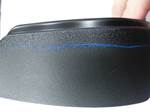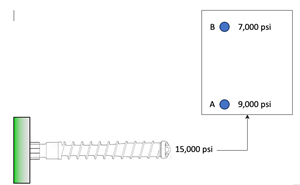Two-Shot Molding and Tool Design
There are a few variations of the two-shot molding process, and each has implications for tool design.
Those not familiar with two-shot injection molding may assume that it’s complex. Yes, it adds another element to part production by involving a second material and process, but it’s not really all that complicated.
There are a few variations of two-shot molding, including rotary platen, movable core, and overmold. The first two require a second injection unit, two runner systems, and two processes. The latter, in most cases, involves two separate molds—one for each material—but can also be run with one mold, two runner systems, and pick-and-place part transfer, either manually or with a robot.
It’s important to understand what materials are being used and their ability to bond to each other. A mechanical bond is necessary—with details and holes in the part design—but some materials do not like to adhere to each other. Most of my experience is with using TPE or TPU as the second shot and PP, PC/ABS, or ABS as the first shot (substrate). There are also cases were the same material with different colors or additives is used for two-shot molding.
Rotary two-shot molding, from my perspective, is the simplest version of the options, But there are still critical things to consider, such as tooling, crush, support and the processes for both shots. In this article, I will focus on the version of the process that uses a rotary platen. The tool itself can have a rotary plate built in, actuated by hydraulics or a rack system. This makes the tooling a little more complex and typically is used when the molder does not do a lot of two-shot molding.
The rotary platen option itself may have two very different meanings to some molders. The simpler one—which I am addressing here—is a vertical platen on one face of the clamp that rotates on a horizontal axis. The other—far more complex—is often referred to as a “cube mold” or “spin stack.” It is a center stack with two or four faces that rotates on a vertical axis. This creates a multi-daylight stack-mold configuration, which is the most complex and costly version of a rotary two-shot mold.
With the simpler rotary platen, as defined above, the tooling itself is not that complex; you just have a second runner system and two sets of ejector plates. The movable half is the half that rotates. If you are producing one part per cycle, there will be two ejector cavities (movable half) and two cover cavities (stationary half). The two ejector cavities will be identical, and the cover cavities will have one for the first shot and one for the second shot. So the pattern continues with multiple parts: Two parts in each cycle would have four ejector cavities and four cover cavities. Again, the four ejector cavities would be identical and the cover cavies would have two cavities for the first shot and two cavities for the second shot.
With a rotary-platen mold, it is critical to have locators on the mold and the machine platens to ensure that it is exactly on center of the rotary platen. If the mold is not exactly on center, you will have alignment issues; when the mold rotates 180° it can damage the leader pins, bushings, and shutoffs. It is also important to consider tonnage with part surface area. In most cases your cavities will be off-center—first shot on one half and second shot on the other half—so you will not have full advantage of the machine tonnage to compensate for the cavity plastic pressure.
As I mentioned, the movable/rotating half contains the first-shot cavities and the stationary half contains cavities for the first shot and the second shot. After injection, the mold rotates to align the first shot with the second-shot cavity. So in one cycle you are molding the first shot with the base material and molding the second-shot material over the first-shot parts from the previous cycle. There are two sets of ejector plates because you are only ejecting the parts with both materials molded, leaving the others to have the second shot molded. There are two important things to consider in the tool design for the first shot when it is in the second-shot position: crush and support.
Crush would be defined as the shutoff to prevent the second-shot material from flashing or bleeding out onto the first-shot plastic where it doesn’t belong. Crush is a raised area of cavity steel that presses into the first shot to prevent flash, typically 0.003-0.005 in. Also, in areas with thicker wall stock on the first shot, you may have to add extra crush to compensate for the extra shrinkage. You can crush by adding steel to the second-shot shutoff or adding first-shot material by removing steel.
You also need to make sure the first-shot part is supported in the second-shot cavities to prevent the second-Shot cavity pressure from deforming or compressing the first-shot material. I have seen many times where the first-shot part was not supported properly, which contributed to flash and deformed parts. Remember that the second shot is applying thousands of pounds of plastic pressure against the first-shot plastic, not just the steel.
The other version of two-shot molding is the movable core, which does not require a rotary platen. The cavitation will be like a normal mold: one part, one cavity. The movable cores move internally to adjust for the second shot. The mold closes and injects the first shot; then the first-shot core/slide is pulled, the second-shot core/slide is set, and then the second shot is injected. There are cases where there is just one core/slide, which pulls back after the first shot and creates the cavity for the second shot. In either case, the setup and process are the same.
Concerning tool design, you need to make sure the first-shot cavity has support against the second-shot cavity pressure. At times, ribs or undercuts are needed to hold the first shot in place to prevent flash and deformation. Make sure your hydraulic cylinders actuating the cores are robust enough to resist the cavity plastic pressure or you will be struggling with flash and narrow process windows.
Over the years, I have preached about robust process windows. In two-shot molding, this becomes a greater focus with another variable involved. People often will process the first shot to address issues with the second-shot process, or the opposite. Crush, support, deflection, and inadequately sized cylinders can all contribute to issues that many molders will process around, putting them at risk for quality issues and scrap.
ABOUT THE AUTHOR: Randy Kerkstra has been in the plastics industry for more than 26 years, occupied frequently with troubleshooting injection molding. He is currently a tooling manager for a large, multi-plant molding and manufacturing company. Contact: kbmoldingsolutions@gmail.com.
Related Content
Polyethylene Fundamentals – Part 4: Failed HDPE Case Study
Injection molders of small fuel tanks learned the hard way that a very small difference in density — 0.6% — could make a large difference in PE stress-crack resistance.
Read MoreUnderstanding the Effect of Pressure Losses on Injection Molded Parts
The compressibility of plastics as a class of materials means the pressure punched into the machine control and the pressure the melt experiences at the end of fill within the mold will be very different. What does this difference mean for process consistency and part quality?
Read MoreWhat to Look for in High-Speed Automation for Pipette Production
Automation is a must-have for molders of pipettes. Make sure your supplier provides assurances of throughput and output, manpower utilization, floor space consumption and payback period.
Read MoreUse These 7 Parameters to Unravel the Melt Temperature Mystery
Despite its integral role in a stable process and consistent parts, true melt temperature in injection molding can be an enigma. Learning more about these seven parameters may help you solve the puzzle.
Read MoreRead Next
Solving Issues with Gloss
Your problem may be related to tooling, material, processing, or combinations thereof. Here’s how to find the root cause.
Read MoreLead the Conversation, Change the Conversation
Coverage of single-use plastics can be both misleading and demoralizing. Here are 10 tips for changing the perception of the plastics industry at your company and in your community.
Read MoreFor PLASTICS' CEO Seaholm, NPE to Shine Light on Sustainability Successes
With advocacy, communication and sustainability as three main pillars, Seaholm leads a trade association to NPE that ‘is more active today than we have ever been.’
Read More


















